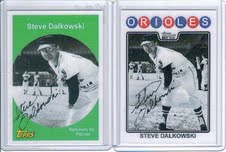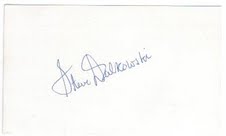 |
| John-William gave Steve the Hollywood treatment with these custom cards! |
Is Steve Dalkowski Hollywood famous? Did he inspire the young pitcher Nuke, portrayed so unforgettably by Tim Robbins, in the movie Bull Durham?
Collector and historian John-William Greenbaum pondered the question, saying:
“It’s like a lot of things regarding Steve: it’s partially true. The thing is, most of the stories you hear about Steve have some basis in reality, but were either “almost true”, like when he clipped the top of a batter’s ear in his third professional baseball game (although the real concern was not the batter’s ear…he wasn’t even moving and Steve thought he killed him for a few minutes…it did end his career and gave him post-concussion syndrome), or “almost false”. There’s one part where they reference Nuke striking out 262 batters and walking 262 batters…that is something Steve did in 1960 with the Stockton Ports in 170 IP.
But the more Orioles guys I spoke with, since I was under the impression it was all Steve, I found out that Nuke’s off-the-field antics seem to be much closer to a pitcher by the name of Greg Arnold, who threw quite hard and had no idea where the ball was going. Think Ryne Duren wild instead of Steve Dalkowski wild, though. Ron Shelton, who wrote Bull Durham, has sometimes said it was Steve Dalkowski, sometimes he’s said the character was completely fictional, and other times he’s said part Steve Dalkowski, part fiction. Sometimes you get the feeling that he changes his mind. I’m not alone in that sentiment and some ballplayers noted it. Obviously, I can’t get into his head and figure out how much is Steve, how much is Greg Arnold, etc., but I corresponded with one of the very few men to have played with Steve, Ron Shelton (himself a former pro ballplayer), and Greg Arnold, and that was the late George Farson, who by the way caught Steve’s last game in the Orioles organization.
Mr. Farson was friendly with Mr. Shelton at the very least, and what he did was write me with a bunch of facts about Steve, a bunch of facts about Greg, a bunch of facts about the fictional Nuke LaLoosh, and told me to draw my own conclusion. To anyone who reads that letter, Nuke LaLoosh was Greg Arnold with Steve Dalkowski’s arm and wildness. Again, I can’t claim to be Ron Shelton–he knows himself better than I do–but I can claim to have a guy’s opinion with a unique perspective (only pitcher Rick Delgado, whom I’ve not been able to locate but I believe lives in Puerto Rico, also was a teammate of Steve’s, Mr. Shelton’s, and Greg’s).”
One thoughtful, sincere letter can open new doors in baseball history. I can’t wait for the publication of the Steve Dalkowski book, John-William. Well done!
Coming Friday: Meet Laura Brookman, autograph barrier breaker!



Here are a couple of segments from my book “Beating About the Bushes” regarding Dalkowski. A couple of years ago I was in contact with John-Williams and gave him permission to use any of the 31 pages I wrote about Steve.
“Once a person becomes legendary there are untruths repeated over time, building energy, until the real story is lost and they become fact. The internet has become the standard for research and once something is logged in it is available for repeating whether it is correct or not.
The most reported and repeated has Steve being the model for Tim Robbins character, Nuke Laloosh, in Ron Shelton’s classic movie, “Bull Durham”. The real character was probably a combination of Dalkowski and Greg Arnold.
Greg was a wild right hander who played a guitar and drove a red sports car, same as Nuke. Steve was a left hander who couldn’t carry a note let alone play the guitar and didn’t have a driver’s license because of his drinking problem. Arnold and Shelton playing together four seasons makes sense to me. Dalkowski was long gone before Shelton signed and word of mouth stories about Steve were a decade old. Arnold fits the description of Nuke far better than Dalkowski but Shelton probably blended the two together for his character.
The most blatant abuse of the truth can be found on the website, http://www.sportshollywood.com. “One of his wilder pitches hit an announcer—up in the announcer’s booth, and he finished one season at Stockton with 262 strikeouts and 262 walks. Writer/director Ron Shelton was playing on that team with Dalkowski in 1960, and he used the announcer incident and these exact statistics in his screenplay for Bull Durham. He used Dalkowski as the model for the films character Nuke Laloosh”. In 1960 Shelton might have been old enough to be the bat boy since his professional debut in the Orioles system wasn’t until 1966.
It was time to celebrate our win and on the return to the hotel Steve asked if I would be his partner for the night. This was not an unusual request since there was no one else for him to turn to except me and I had lent him twenty dollars. His performance raised questions in my mind and there was no hesitation in agreeing to join him.
Lewiston had the appearance and feel of being one of the last Wild West cities left in America since urban renewal and freeways were decades away and we were staying at the Lewis and Clark Hotel. Both the city and hotel were aging but provided a strong feeling as to their past. It took little imagination to see the legendary explorers traveling through and what they might have observed.
Ripken wisely placed every bar off limits within the city. Cowboys seldom mixed well with Native Americans, tourists or ball players. In order to party, one had to rent a cab and travel far from the comfort zone of our hotel. This was the only city I played in with the possibility of total team celibacy. We were staying at a hotel near a night club seating two hundred and a live band. Steve decided this is where we were going to celebrate his win and there was no negotiating
Females were in abundance and we had no worry about time except for our departure to the park the next day. Perfect seating became available at the center of the bar close to the dance floor. It was only eleven and we had three hours to find companionship for the evening and Steve was my leader.”
Tim Sommer
Author of Beating About the Bushes